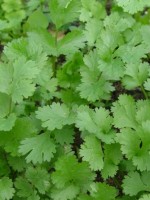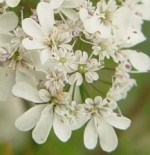 Also known as cilantro and Chinese parsley, coriander is a warm weather annual and a member of the carrot family, Apiaceae, that also includes celery, parsley, and Queen Anne’s lace. It is native to southern Europe and the eastern Mediterranean but is widely cultivated elsewhere as a culinary herb including the US, mostly in California. Growing 2-3′ tall, plants form a basal clump of pinnately compound leaves with the lower ones roundish and lobed, the upper ones finely divided and fern like. The very small white to pinkish flowers appear on short stalked umbels 2″ across and are followed by brownish yellow, spherical seeds. The leaves, stems, roots and seeds are edible and popular in the cuisine of Mexico, the Middle East, south Asia, and China The leaves and stem have a citrusy sage taste to most people but a soapy taste to some while the roots have a similar taste but are also nutty. The seeds lack the sage flavor but are citrusy. The genus name, Coriandrum, comes from the Greek word κορίαννον, koriannon, derived from Greek word κόρις, kóris , meaning bed bug and refers to the foul smell of the unripe fruit. The specific epithet, sativum, comes from Latin word meaning cultivated.
Also known as cilantro and Chinese parsley, coriander is a warm weather annual and a member of the carrot family, Apiaceae, that also includes celery, parsley, and Queen Anne’s lace. It is native to southern Europe and the eastern Mediterranean but is widely cultivated elsewhere as a culinary herb including the US, mostly in California. Growing 2-3′ tall, plants form a basal clump of pinnately compound leaves with the lower ones roundish and lobed, the upper ones finely divided and fern like. The very small white to pinkish flowers appear on short stalked umbels 2″ across and are followed by brownish yellow, spherical seeds. The leaves, stems, roots and seeds are edible and popular in the cuisine of Mexico, the Middle East, south Asia, and China The leaves and stem have a citrusy sage taste to most people but a soapy taste to some while the roots have a similar taste but are also nutty. The seeds lack the sage flavor but are citrusy. The genus name, Coriandrum, comes from the Greek word κορίαννον, koriannon, derived from Greek word κόρις, kóris , meaning bed bug and refers to the foul smell of the unripe fruit. The specific epithet, sativum, comes from Latin word meaning cultivated.
The use of coriander goes back to ancient times. It was found in King Tut’s tomb, is mentioned in the Bible in regard to manna, and was recorded on one of the Linear B tablets from 2nd millennium BC Greece. With such a illustrious history you would think that it is easy to grow but, unfortunately for many of us, it presents a challenge. Flowering is triggered by increasing day-length so if you buy a plant in the spring it will quickly grow, flower, and die with little time allowed for harvesting the leaves. The best solution is to start plants indoors and get them outside right after the last frost date. Start more seed in late summer for a fall crop.
 Type: Annual herb.
Type: Annual herb.
Bloom: Small white flowers are borne in lacy umbels in spring and fall.
Foliage: Bright green, pinnately compound, roundish leaves resembling flat leaf parsley.
Size: 24-30” H x 12” W.
Light: Full sun to part shade.
Soil: Fertile, light, well-drained; pH 6.6.
Fertilizer: Use water soluble 20-20-20 every two weeks.
Care: Water weekly during dry spells. Harvest leaves as often as you need them; puree and freeze the surplus. To obtain seeds, let the flowers go to seed, hang and dry the flower heads.
Pests and Diseases: Mites (remove with strong spray of water)
Propagation: Seed (direct seeding is best as plants do not transplant well).
Companion plants: Caraway, Anise.
Outstanding Selections: ‘Festiva’
